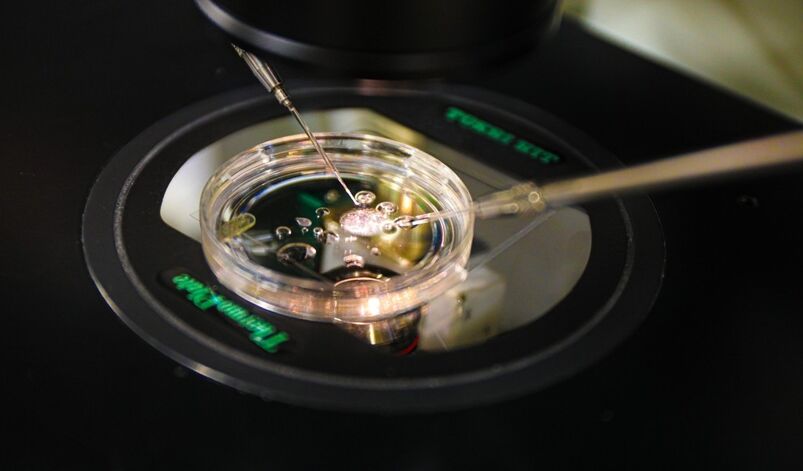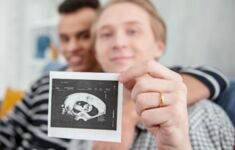
New research to tackle infertility again suggests it’s possible to convert skin cells into egg cells. The technique uses the same method to create Dolly, the cloned sheep, some 20 years ago.
Although researchers say a practical use is at least ten years away, they believe it could help infertile couples and women unable to produce eggs.
It could also be used by two men to create an embryo using both their DNA. This would then be carried to term by a surrogate mother.
How about we take this to the next level?
Subscribe to our newsletter for a refreshing cocktail (or mocktail) of LGBTQ+ entertainment and pop culture, served up with a side of eye-candy.
At present, gay male couples wanting a biological child of their own will need an egg from a donor. This has DNA from the biological egg donor. Semen from one of the men then fertilizes the egg.
Oregon study
Researchers at the Oregon Health & Science University (OHSU) have undertaken this new study. The results appeared in the journal Science Advance.
They undertook the process, known as in vitro gametogenesis (IVG), in mice.
They removed the nucleus from a skin cell. That’s the important part of the cell that carries all its genetic information. They then placed it in a donor egg cell which had its own nucleus removed.
According to an OSHU press statement, “The investigators coaxed the skin cell’s nucleus into reducing its chromosomes by half, so that it could then be fertilized by a sperm cell to create a viable embryo.”

“The goal is to produce eggs for patients who don’t have their own eggs,” said senior author, Dr. Shoukhrat Mitalipov, director of the OHSU Center for Embryonic Cell and Gene Therapy.
One of the key elements of the process is the skin cell nucleus dividing into two when introduced to the egg cell. In some cases, its chromosome pairs split perfectly in two. However, this wasn’t always the case. The process must be refined to avoid genetic abnormalities occurring in the resulting embryo.
OHSU scientists demonstrated proof of concept in a previous report published in 2022. “This publication basically shows how we achieved [it],” said Mitalipov.
“In the next phase of this research, we will determine how we enhance that pairing so each chromosome pair separates correctly.”
Mouse pups produced in Japan
Other researchers have been looking at how to take a stem cell—the most basic, embryonic type of human cell that has yet to develop into a specific type of cell (brain, muscle, liver, etc)—and turn them into egg or sperm cells. OSHU says its process skips that challenge.
Another member of the OSHU team says the technique requires a few years more of analysis.
“This gives us a lot of insight,” said Paula Amato, M.D., professor of obstetrics and gynecology. “But there is still a lot of work that needs to be done to understand how these chromosomes pair and how they faithfully divide to actually reproduce what happens in nature.”
The Oregon study follows up a similar study published by Japanese researchers last year. They managed to create mouse pups using the DNA from two male mice. However, that was via a slightly different technique that reprogrammed male skin cells into stem cells.
Related:
New scientific breakthrough could pave the way for two men to have biological babies together
Cells from two male mice have created a baby without the use of an egg from a female.























ZzBomb
I mean, this just continues to show why calling an embryo a “baby” is just plain stupid. You can’t take the nucleus out of a full grown baby! Also if you keep babies in freezers they tend to die quickly, where embryos can be sustained for long term under such conditions.
But ya know, logic and all.
m
I would like to up vote for comment. It’s clear and concise.
abfab
Is a chicken egg an unfertilized embryo?
During their exploration of chicken embryology, youth learn that for a chicken to develop from an egg it must be fertilized. Most eggs sold commercially in the grocery store are from poultry farms and have not been fertilized. In fact, laying hens at most commercial farms have never even seen a rooster.
MSU Extension Service
OH THOSE POOR GIRLS!
ZzBomb
@Brian
So are “unborn babies” but again, ya know, logic.
abfab
Hi Zz…you replied during his 4 minute editing stage which Brian pulled the plug on. S no, you’re not crazy imaging things.
ZzBomb
Hey Abfab,
Thank you. Kind of figured but all good.
Hope you are well.
abfab
Yes, fine. The calla lillies are in bloom, dear.
Brian
If this technology becomes possible and reliable, I wish we would use it for projects like saving endangered species. (Think of the tortoises, rhinos, etc., where there’s only a single individual remaining, and in some cases it’s one male.)
Gay male couples, lesbian couples, and really also a huge number of heterosexual couples should be pointing their attention at the foster kids and orphans. Spending a million dollars to make your own clone is so disgustingly selfish that it runs counter to the whole concept of love and family. Save the money, and then donate that million to another cause.
abfab
The baby business is unstopable! MAKE IT STOP!
abfab
I love my dogs and I love my Barbra but this is f ucking ridiculous. This goes to your important point, Brian.
For those of us who have been following the ongoing narrative that is Barbra Streisand and her cloned dogs, the legendary singer provided an essential visual update of sorts on Wednesday on her Instagram account.
As we know—what, you don’t remind your various group texts at least once a week that *Barbra Streisand wrote a piece for the New York Times titled, literally, “Why I Cloned My Dog”?!—Streisand had clones of her Coton de Tulear Samantha made after Samantha passed away. (The process costs about $50,000.) The runt of the cloned four-pup litter sadly didn’t survive, and Streisand gave one of the clones away, but she kept two—Miss Violet and Miss Scarlet. (She had previously adopted another puppy, Miss Fanny, the third of her current squad.)
-Vanity Fair
so much for Second Hand Rose………
monty clift
Oh, please with the sanctimonious BS. Gay people are allowed to have their own biological children, and the financial cost is irrelevant. If they are willing to spend that much money, then it demonstrates what love they can provide for that child. What is disgusting is that you think we should be obligated to pick up the children that were SELFISHLY abandoned at orphanages by heterosexuals. Why don’t you go tell them to stop breeding and dumping their kids into the system, which, btw, costs millions more than any child received by IVF.
abfab
”money, then it demonstrates what love they can provide for that child.”
Oh you naive, gullible, idiotic little fool.
abfab
Monty. Stop talking because you will never be able to dig yourself out the holes you’ve dug and fallen into over the years. Or keep going, you’re an interesting case study in the ”just because you’re Gay it doesn’t mean you’re smart” department.
still_onthemark
I saw recently they’re hoping to bring back the woolly mammoth and the dodo ?!
monty clift
Oh, look, the moronic homophobic GOP troll has reared its ugly little head. @abfab is spending another lonely night under its bridge.
abfab
The Dodo is already here.^
monty clift
“you’re an interesting case study in the “just because you’re Gay it doesn’t mean you’re smart” department.”
This coming from a T-chaser MAGA loser like you is hilarious. Projection, thy name is abfab.
abfab
Imagine the postpartum depression drama in this household! Times two! Oy vay….no thanks.
monty clift
Imagine being a rancid skidmark. Oh, I’m sorry, you don’t have to imagine that.
ShaverC
Yikes. Dr Frankenstein. Scary.
abfab
Right. You’re more of an imaculate conception sort of queen….
ZzBomb
Never actually read Frankenstein have you?
abfab
Or been told the truth about the Storks.
ZzBomb
Or understands genetics
ShaverC
Zz, What went wrong with his little experiment? I think there’s only so much meddling we need to do with something like this.
SoPluckyWhat
What went wrong was when Igor dropped the smart brain and chose Abi…..Abi Normal. Wait, you thought the story of Frankenstein was real?
bachy
I understand and appreciate the indisputable importance of reproduction, but I prefer viewing from a safe distance the exquisite happiness of parenthood.
abfab
How very Brady Bunch. : ) Sure, Jan.
I do enjoy my godfather/uncle roles, and then comes the distance. BYE KIDS!
SoPluckyWhat
I could barely afford paying for my first partners many spans of unemployment. I also enjoy my many nieces and nephews and many great nieces and nephews at family gatherings. And then I go home to a enjoy nice and quiet.
inbama
That this research may be of use to some wealthy gays (as surrogacy is now) is just a biproduct and not the point. It’s all part of the movement that has swallowed up every gay and lesbian civil rights and liberation organization – as well as the ACLU.
It’s called “transhumanism” and you can read about it in this book by Martine Rothblatt, founder of SiriusXM, who is perhaps one of the four most influential transwomen (like the other three, all heterosexual m2fs): “From Transgender to Transhuman: A Manifesto On the Freedom Of Form.”
abfab
Why would anyone read about it when we have you.
RIGay
So my question come with the egg (and it’s an EGG, not a BABY) of itself – would not the DNA of the egg donor be part of the equation? Meaning that the baby would only be 2/3rds that of the fathers?
It’s a great idea and all, but I am not entirely sure of the genetic science going into this.
abfab
JERRY! ELAINE! DO YOU WANT TO SEE THE BABY? YOU HAVE TO COME UPSTAIRS AND SEE THE BABY!!!!!!!!!!!!!!!!!!!!!!!!!!!
still_onthemark
The baby is breathtaking!
abfab
Isn’t he GAW JUS!
DavidIntl
That rare article on Queerty that is actually worth reading. This could be a game-changer for gay couples, certainly. And hopefully it can quickly be brought to the stage where it relatively affordable and not something available to only the wealthiest members of society.
No, it isn’t selfish to want to have a child that is your biological descendant – that is 100% human nature.
For a same-sex couple that has a child together, but which is biologically linked to only one of them, there will always be the risk that on some visceral level they don’t feel the same connection.
And those who are asserting that gay couples should just adopt, I can assure you from the experience of people close to me that that is often very problematic. Without getting into the nature vs. nurture debate, the most dedicated nurturing in the world can definitely not always overcome problematic nature.
Lastly, before anyone concludes that what I have said here is somehow hateful, I would point out that I am biologically related to only of my parents.